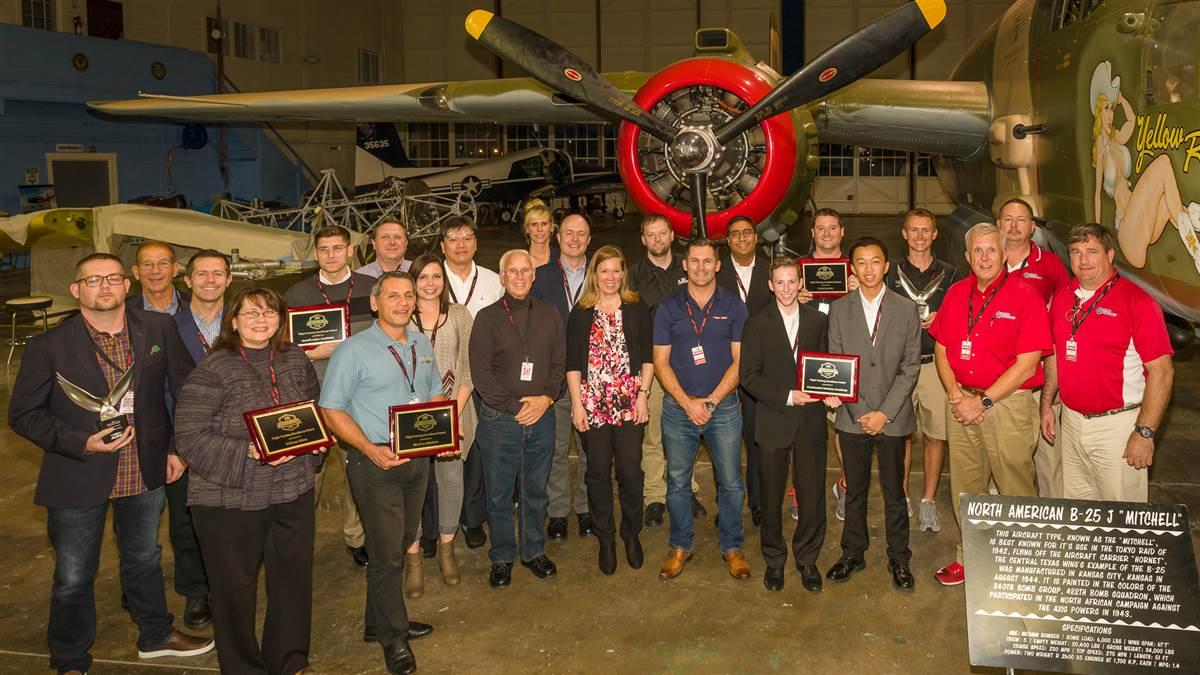Training News and Notes
Skyline flight. TV crews capture the news for New York City Channel 5 Fox affiliate in Helinet Aviation's Airbus Helicopter AS350. This is what is known as the “Hudson River Corridor,” a popular VFR passage along the Manhattan shore that offers a unique perspective on one of the nation's most remarkable cities.

WHAT: Airbus Helicopter AS350
WHERE: New York, New York
PHOTOGRAPHER: Mike Fizer
AOPA NEWS
Honoring flight schools and instructors
Flight Training Excellence Awards presented
A Florida flight training business that keeps its customers on course toward their goals, and a Maryland flight instructor who has gone out on her own for the love of instructing have been voted winners of AOPA’s 2016 Flight Training Excellence Awards.
Flight Training Professionals, based at Executive Airport in Orlando, Florida, and Brenda Tibbs—an experienced instructor who launched a new venture, Bravo Flight Training, in Frederick, Maryland—received their awards October 25 at the Redbird Migration Flight Training Conference in San Marcos, Texas.
Nine additional flight schools and 10 more flight instructors were judged to be “outstanding” by their students; 60 flight schools and 50 flight instructors also were recognized as being on the flight training “honor roll.” Winners and more information will be profiled in the February 2017 issue of Flight Training magazine.
The Student’s Choice Award was given to Paragon Flight of Fort Myers, Florida, as the flight school that received the highest number of positive nominations. This year’s President’s Choice Award winner was Take Flight Aviation of Montgomery, New York, selected by AOPA President Mark Baker for significant and innovative contributions to the flight training community.
The 2016 AOPA Flight Training Poll gave aviators the opportunity to provide feedback about their recent flight training experience, a way to “stand up and sound off for the future of flight training.” Voting took place between May 23 and August 22, with 11,356 ballots being cast, and a total of 789 flight schools and 1,515 flight instructors receiving votes.
The Flight Training Excellence Awards, now in its fifth year, is one of the initiatives under You Can Fly, AOPA’s umbrella program to make flying more accessible and affordable by pursuing a range of targeted approaches to building the pilot community. Initiatives include supporting flying clubs and encouraging best practices in flight training, getting rusty pilots back in the air, and helping high school students discover the potential for careers in aviation.
The Flight Training Poll measured the performance of flight training providers based on educational quality, customer focus, community, and information sharing—factors that combine to create an optimal flight training experience, according to a study commissioned by AOPA in 2010.
Texas club awarded airplane
AOPA delivers Reimagined Cessna 150
Of the 57 new flying clubs eligible for AOPA’s Flying Club 150 Giveaway, the application from the Nate Abel Flying Club stood out. AOPA President Mark Baker awarded the club the association’s Reimagined Cessna 150 in October.
Tom Barry, the club treasurer, said AOPA’s online resources were the key to getting the club started. “We were able to leverage all of those resources and be successful because of it. All that information was amazing,” he said. The club plans to recruit older pilots to serve as mentors to younger members, and they are fired up to get started.
Flying clubs promote safety, camaraderie, and affordable flying, and foster growth in the pilot community that benefits everyone. The Nate Abel Flying Club application included every element of the best practices and guidance AOPA has developed based on the experience of successful clubs around the country.
“Their application scored very highly in terms of hitting all the key points we were looking for,” said Les Smith, AOPA senior director of pilot community development.
Nate Abel Flying Club will base the Reimagined Cessna 150 at Hicks Airfield, just north of Fort Worth, Texas. AOPA teamed up with Aviat Aircraft to restore the Cessna 150 to like-new condition, and provide a flying club with an airplane that can be owned and operated at low cost.
The 150 Flying Club Giveaway contest was made possible through AOPA’s flying clubs initiative under its You Can Fly program.
INDUSTRY NEWS
Migration fosters ideas, enthusiasm
Redbird brings together training providers and makes magic
By Ian J. Twombly

Part customer meeting, part big-idea conference, part team-building retreat, the Redbird Migration Flight Training Conference again this year proved to be an event unique to aviation. The sixth annual event, held October 24 to 26 at the company’s Skyport fixed-base operation in San Marcos, Texas, featured everything from a model airplane contest for participants to hosting AOPA’s Flight Training Excellence Award presentations.
Now in its sixth year, Migration remains at its core a customer meeting. It’s free to attend, meals are provided, and there are plenty of simulators around for attendees to try—and time in the schedule to buy.
But saying the three-day event is a customer meeting is akin to saying that Redbird is only a simulator company. Customer appreciation days don’t usually include CEOs from aircraft manufacturers. Cirrus Aircraft CEO Dale Klapmeier spoke of the need for more advanced training; Piper Aircraft CEO Simon Caldecott spoke about Piper’s reentry to the training market; and Aero Electric Aircraft Corp. head George Bye appropriately played host to a rousing aircraft design competition.
The event always features one speaker from outside the training industry. Usually the focus is on marketing or instruction from unrelated businesses, with the idea that attendees can apply those concepts to their schools. This year Passur President and CEO James Barry spoke about the importance of big data. Passur’s impact on the airline industry is well established, but Barry says he sees an opportunity for big data to come to general aviation as well. And for flight schools, measuring basic trends such as completion rates can go a long way to improving the quality of the product.
A Migration wouldn’t be complete without some news out of the host. President Jerry Gregoire announced he will step down January 1, handing the role to Charlie Gregoire. Todd Willinger will stay on as CEO, and Jerry will take on the role of co-chairman alongside former AOPA President Craig Fuller.
Gregoire also announced that 2017’s event will be at the EAA Museum in Oshkosh.
Flying Clubs: ‘Winning formula’ works
New flying club the latest addition at thriving Florida airport
By Dan Namowitz
A new flying club in Florida helped a rusty pilot return to active status on the club’s first flight, when the group’s president completed a flight review in its leased Cessna 172. The debut flight of the Aviation City Flying Club from Arcadia Municipal Airport, with President Don Morley in the left seat, was the latest in a series of developments putting the airport on the map as a general aviation destination and reinforcing the airport community’s reputation as strong GA advocates.
The Friends of Arcadia Airport operates a one-of-a-kind, on-airport camping facility featuring a pilot shelter, available to visitors for a fee and by reservation. The group designed, funded, and built the “fly in, camp out” facility.
The Aviation City Flying Club got its start with help from You Can Fly, AOPA’s project to support flying clubs, flight schools, and others who work to make flying accessible and affordable.
Jamie Beckett, AOPA’s You Can Fly ambassador for Florida, presented a seminar about flying clubs. It was a successful get-together that “pulled people in from all over the state,” he said. The flying club-in-development moved forward, working out the lease of a Cessna 172 from a local pilot. “And this all came together in just a few months,” Beckett said. “It’s just a match made in heaven.”
George Chase, the leader of the four-year-old Friends of Arcadia Airport group, emphasizes the “ripple effect” that local airport advocacy has had, both in terms of economic benefits and in having “gained the respect of both county and city officials, and the public” for the pilot community.
Next, he says, is to share the winning formula with other general aviation communities. “Now we just need to get the word out that this type of thing can be great for airports of all sizes,” he said.
ASI NEWS
Learn with the best
Connect with AOPA’s Flight Instructor Refresher Course
The AOPA Air Safety Institute’s Flight Instructor Refresher Course (FIRC) is the most comprehensive FAA-approved CFI renewal program available and the only one that puts all its net revenue back into developing safety programs.
For decades, the two-day in-person FIRC has been widely recognized as the best CFI renewal program led by expert, knowledgeable, and engaging presenters. Its 16-hour syllabus is presented across the country, allowing you to train and network with other flight instructors in your area.
ASI developed its online FIRC program (eFIRC) for desktop and mobile devices, providing training at your own pace and time. You can choose electives from 13 topics—including seaplane safety, runway safety, and helicopter safety—to expand areas that most interest you and best serve your needs. Several ASI courses, such as Teaching VFR into IMC Avoidance, Aging Aircraft, Mountain Flying, IFR Insights: Cockpit Weather, and Public Benefit Flying: Balancing Safety and Compassion, count toward the eFIRC if you have completed them within your two-year renewal window and take a short teaching module and quiz.
ASI does not charge extra for processing CFI revalidation. If you take your renewal program paperwork to the local flight standards district office, be aware that you must make an appointment in advance and be prepared to go through identification procedures.
Web: www.aopafirc.org
Ice isn’t nice
Leave icing for your cake, not your airplane
 You’ll agree after you hear Dean Clark describe the surprise he encountered during a flight that unexpectedly ventured into ice-filled clouds. The accumulation encrusted his Cessna 182 in ice. “That will never happen to me,” you say? Although we can predict high-risk areas for icing, it is not always possible to accurately pinpoint when and where it will occur. Sometimes all the necessary elements seem to be in place, but then nothing happens. On the other hand, when icing seems quite unlikely, it can be a shock to discover it forming on your airplane. Real Pilot Story: Ambushed by Ice will help you understand that even flying a familiar route in a trusted airplane with no serious weather in the forecast can turn out to be more of a challenge than anticipated.
You’ll agree after you hear Dean Clark describe the surprise he encountered during a flight that unexpectedly ventured into ice-filled clouds. The accumulation encrusted his Cessna 182 in ice. “That will never happen to me,” you say? Although we can predict high-risk areas for icing, it is not always possible to accurately pinpoint when and where it will occur. Sometimes all the necessary elements seem to be in place, but then nothing happens. On the other hand, when icing seems quite unlikely, it can be a shock to discover it forming on your airplane. Real Pilot Story: Ambushed by Ice will help you understand that even flying a familiar route in a trusted airplane with no serious weather in the forecast can turn out to be more of a challenge than anticipated.
Web: www.airsafetyinstitute.org/RPSambushedbyice
Get there thanks to fuel in your tanks
 Tapping the fuel indicator will not feed the engine—a healthy fuel reserve will. Watch Would You Fly This Airline? a witty reminder from the AOPA Air Safety Institute’s Pilot Safety Announcement video series to pay attention to fueling and in-flight fuel management so you don’t come up short of your intended destination.
Tapping the fuel indicator will not feed the engine—a healthy fuel reserve will. Watch Would You Fly This Airline? a witty reminder from the AOPA Air Safety Institute’s Pilot Safety Announcement video series to pay attention to fueling and in-flight fuel management so you don’t come up short of your intended destination.
Web: www.airsafetyinstitute.org/psa/airline
TRAINING NEWS
Studying at home
By David Tulis
Online classrooms in Maine
Flight review students have a new option for brushing up on federal aviation regulations, flight maneuvers, and other basic skills needed for the ground school portion of their logbook endorsement. WINGsReality EDU has designed a blended online and live classroom learning environment, co-founder Michael Lessard told AOPA. Lessard said the physical school, based in Maine, had simply outgrown its confines, so he spread the learning process out from a classroom to a student’s own room—wherever that may be.
The flight review classes are scheduled through the fall and winter from 6 to 9 p.m. Eastern time with Lessard leading the lesson plan from WINGsReality EDU’s campus. He encourages students to participate in discussions either in person or remotely via a computer and video hookup. Cameras are placed around the room so everyone has a good view. “Online viewers can ask questions or raise their hands, the same as live students in the room,” he said.
Five different training modules are presented to the class, along with homework and deadlines, to keep everybody on track. Students must pass each module before continuing to the next one. Although Lessard said the ground school review material wasn’t a pushover, no one has failed yet.
“Each class is recorded and archived,” said Lessard, “and students can watch them over and over as many times as they want or need.” Since all material will be archived, if a student misses a class, he or she can still catch up later.
WINGsReality EDU has offered private pilot ground schools for 11 years that were previously based at the University of Maine, with a satellite location near Atlanta. With the new concept Lessard said he combined the best of his in-person and online teaching methods to appeal to busy aviators.
Completion of the flight review course earns students four FAA WINGS credits—two basic and two advanced credits, said Lessard.
The flight review ground school costs $39.95 and will be offered once per month, with consideration that weekday evenings rather than weekends might be more appealing during the milder weather of spring and summer.



